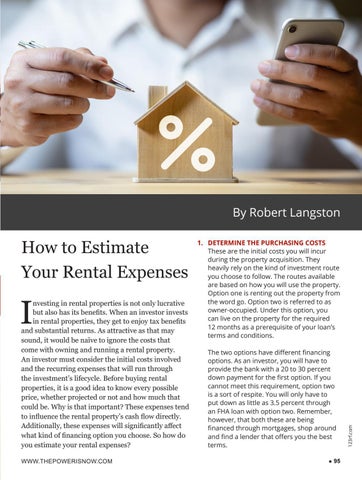By Robert Langston
I
nvesting in rental properties is not only lucrative but also has its benefits. When an investor invests in rental properties, they get to enjoy tax benefits and substantial returns. As attractive as that may sound, it would be naïve to ignore the costs that come with owning and running a rental property. An investor must consider the initial costs involved and the recurring expenses that will run through the investment’s lifecycle. Before buying rental properties, it is a good idea to know every possible price, whether projected or not and how much that could be. Why is that important? These expenses tend to influence the rental property’s cash flow directly. Additionally, these expenses will significantly affect what kind of financing option you choose. So how do you estimate your rental expenses? WWW.THEPOWERISNOW.COM
1. DETERMINE THE PURCHASING COSTS These are the initial costs you will incur during the property acquisition. They heavily rely on the kind of investment route you choose to follow. The routes available are based on how you will use the property. Option one is renting out the property from the word go. Option two is referred to as owner-occupied. Under this option, you can live on the property for the required 12 months as a prerequisite of your loan’s terms and conditions. The two options have different financing options. As an investor, you will have to provide the bank with a 20 to 30 percent down payment for the first option. If you cannot meet this requirement, option two is a sort of respite. You will only have to put down as little as 3.5 percent through an FHA loan with option two. Remember, however, that both these are being financed through mortgages, shop around and find a lender that offers you the best terms. l
95
123rf.com
How to Estimate Your Rental Expenses















